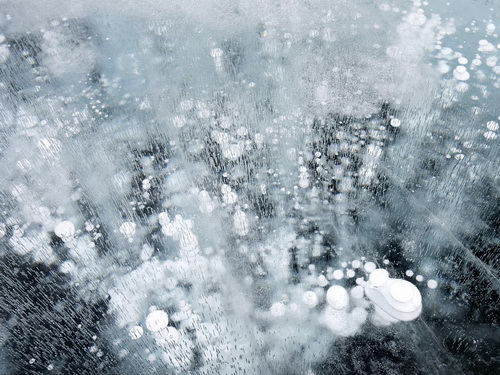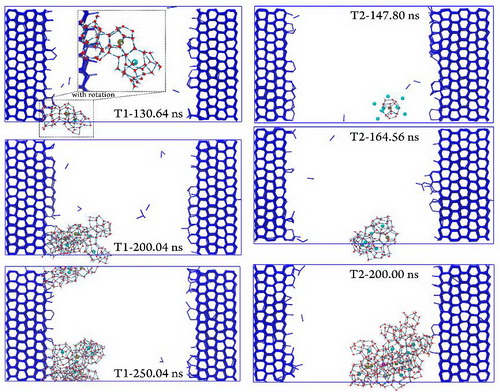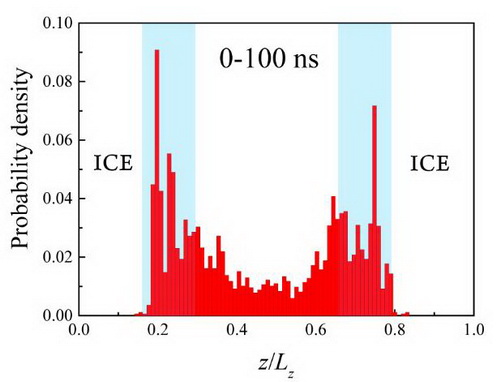
Gas hydrates under the ice, Lake Baikal(Image from www.vcg.com)
Gas hydrates are crystalline compounds made from space-filling cages of water molecules that accommodate small gas molecules. Although ice which is also made up with water molecules is widely used in gas hydrate formation experiments, the effects of ice on hydrate nucleation and what happens in the quasi-liquid layer of ice are still not well understood. Recently, Dr. ZHANG Zhengcai and Prof. GUO Guangjun from IGG, used high-precision constant energy molecular dynamics simulations to study methane hydrate nucleation from vapor–liquid mixtures exposed to the basal, prismatic, and secondary prismatic planes of hexagonal ice (ice Ih). Their work was published in Physical Chemistry Chemical Physics in July, 2017.
The simulations show that methane hydrate can nucleate either on the ice surface heterogeneously or in the bulk solution phase homogeneously (Figure 1). Several factors are mentioned to be able to promote the heterogeneous nucleation of hydrates, including the adsorption of methane molecules at the solid–liquid interface, hydrogen bonding between hydrate cages and the ice structure, the stronger ability of ice to transfer heat than that of the aqueous solution, and the higher occurrence probability of hydrate cages near the ice surface than in the bulk solution (Figure 2).
However, other factors, including the hydrophilicity of ice and the ice lattice mismatch with clathrate hydrates can inhibit heterogeneous nucleation on the ice surface and virtually promote homogeneous nucleation in the bulk solution. The efficiency of ice as a promoter and as an inhibitor for heterogeneous nucleation is different. It is estimated that the former is larger than the latter under natural conditions.
Additionally, utilizing the benefit of ice to absorb heat, the microcanonical molecular dynamics simulation of hydrate formation with ice can mimic the phenomenon of ice shrinking during the heterogeneous nucleation of hydrates and lower the overly large temperature increase during homogeneous nucleation. These results clarify the nucleation mechanism of methane hydrate in the presence of ice.
This work was supported by National Natural Science Foundation of China (Grant No. 41372059 and 41602038) and the Strategic Priority Research Program of the Chinese Academy of Sciences (Grant No. XDB10020301). (Zhengcai Zhang and Guang-Jun Guo, The effects of ice on methane hydrate nucleation: a microcanonical molecular dynamics study. Physical chemistry chemical physics, 2017, 19: 19496-19505.) (Link)

Figure 1. Methane hydrate can nucleate heterogeneously (T1), and nucleate homogeneously (T2). Water molecules in ice are represented by blue tubes. Oxygen and hydrogen atoms in cage clusters are in red and white, respectively. Hydrogen bonds are in light blue. Methane molecules in 512 cages are represented by tan spheres, while those in other cages are shown as cyan spheres.(Image by GUO)

Figure 2. The probability density of filled face-saturated cages along the z direction during the induction time. The light blue area is the ice–solution interface.(Image by GUO)
Contact:
GUO Guangjun
Institute of Geology and Geophysics, Chinese Academy of Sciences (IGGCAS)
Tel: +86-10-82998369
E-mail: guogj@mail.iggcas.ac.cn